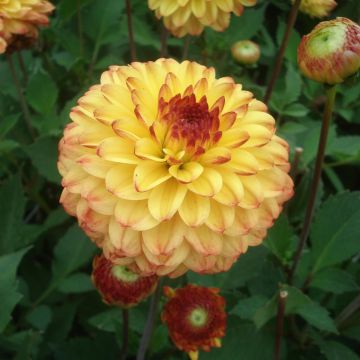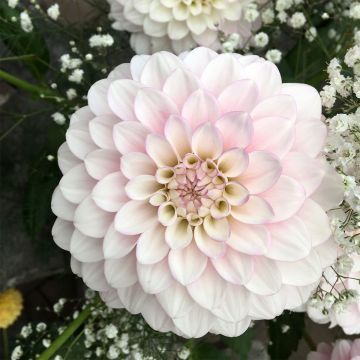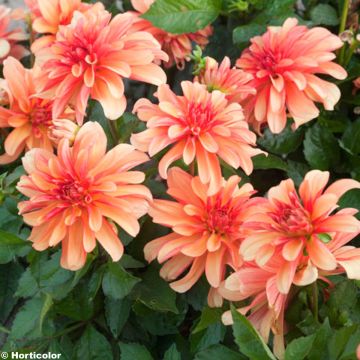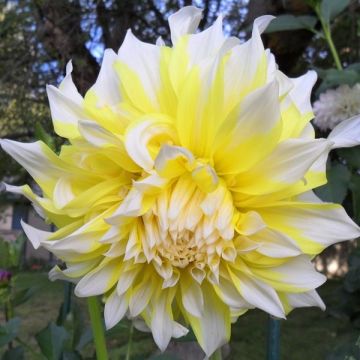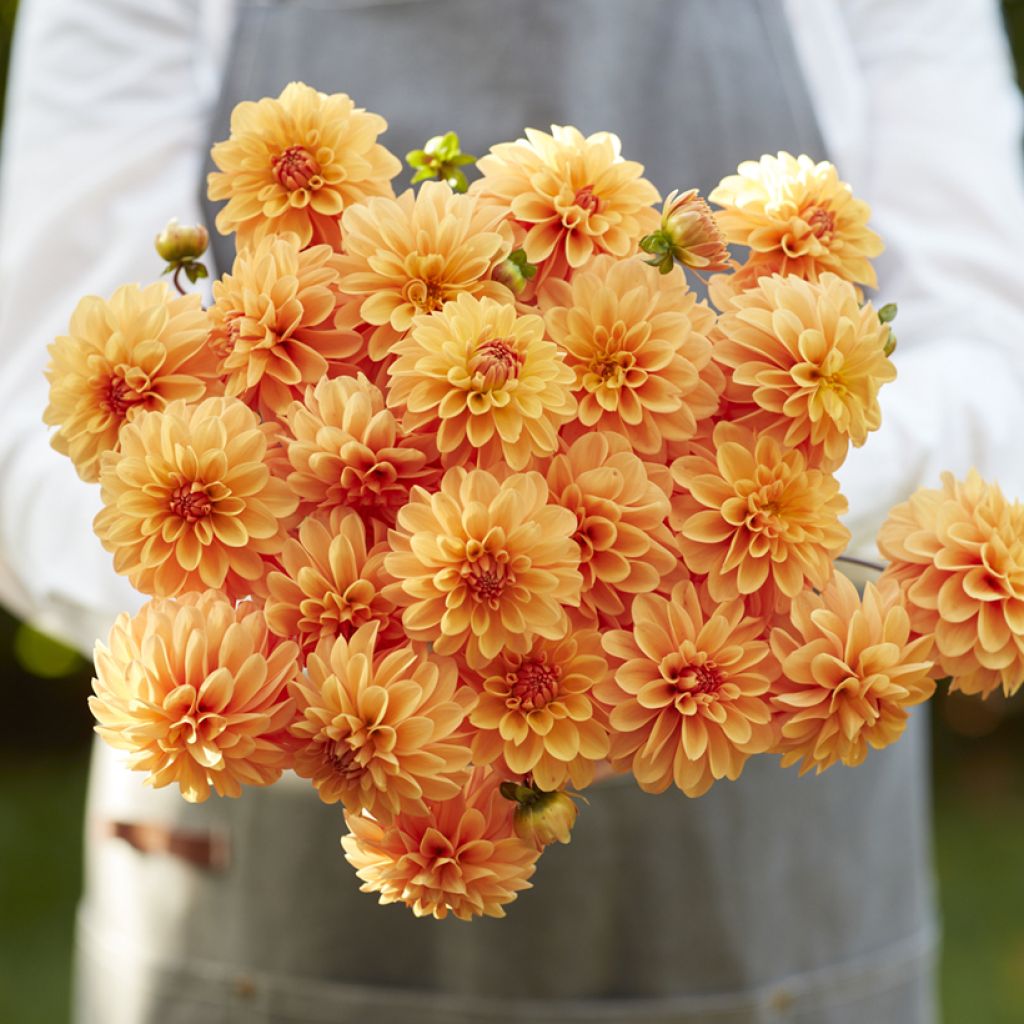

Dahlia Bazuin® Bright Orange
Dahlia Bazuin® Bright Orange
Dahlia Bazuin® Bright Orange
This item cannot be shipped to the selected country
Delivery charge from €5.90
More information
Schedule delivery date,
and select date in basket
This plant carries a 6 months recovery warranty
More information
We guarantee the quality of our plants for a full growing cycle, and will replace at our expense any plant that fails to recover under normal climatic and planting conditions.
From €5.90 for pickup delivery and €6.90 for home delivery
Express home delivery from €8.90.
Does this plant fit my garden?
Set up your Plantfit profile →
Description
The Dahlia Bazuin® Bright Orange is a variety of Dahlia known as 'head' Dahlia, with a beautifully double flower displaying a lovely gradient of orange tones. A vibrant colour that can vary depending on the temperature and fades as the flower ages. This Dahlia, of medium stature, blooms from summer until the first cold spells on dark stems. Its flower holds up very well in a vase. In the garden, pair it with asters or grasses.
The Dahlias, belonging to the Asteraceae family, originally come from the high plateaus of Mexico. Their flower heads, commonly referred to as "flowers," are highly appreciated. Today, thanks to the numerous varieties created by humans, they adorn gardens worldwide, much to our delight.
The Bazuin® Bright Orange variety forms a clump of leafy stems averaging 1.10 m in height and 60 cm in diameter after 3 to 4 months of cultivation. It is classified among Dahlias of the decorative group with 'head' type flowers. In this category, the heads have no visible centre, and they are composed of numerous regularly arranged petals (ligules) that may be more or less curled in on themselves, even tubular, never opening out. This includes varieties that form true balls, such as pompons (diameter less than 6 cm) and 'heads' (diameter over 6 cm). The heads of the Bazuin® Bright Orange variety measure up to 11 cm in diameter. The plant has an upright and bushy habit. The flowering of this variety starts in July and continues until October-November, if faded flowers are regularly removed or used in bouquets. The stems, coloured dark purple, bear leaves divided into 3 or 5 very toothed lobes. The leaves are shiny green.
The Dahlia Bazuin® Bright Orange stands out with its vibrant flowers, perfect for enriching bouquets alongside varieties with single or pompon flowers, in shades of blue, mauve, and purple. It harmonises beautifully with bronze or purple foliage, such as that of bronze fennel, or with the acid green hues of lady's mantle. In flower beds, it creates radiant colour accents, especially when combined with grasses like foxtail barley or Pennisetum x advena 'Rubrum' and cordifolius asters ('Little Carlow', 'Blue Heaven'), which bloom simultaneously. It enhances bouquets until the end of the season.
True stars of borders and cottage gardens, dahlias effortlessly complement the most beautiful flowers and also find their place alongside vegetable plants. Originating from Mexico, these tuberous plants were initially grown as root vegetables, but their poor taste quickly relegated them to the role of ornamental plants. Today, with their incredible diversity of shapes and colours, dahlias are considered one of the most magnificent flowers in our gardens.
Report an error about the product description
Plant habit
Flowering
Foliage
Botanical data
Dahlia
Bazuin® Bright Orange
Asteraceae
Cultivar or hybrid
Other Pom-pom Dahlias
Planting and care
The Dahlia Bazuin Bright Orange is easy to grow in all regions. For a generous flowering, it is good to follow some simple rules, plant the tubers in a sunny position from the last frosts, rich, fresh and well-drained soils are perfect. However, stagnant moisture would promote tuber rot. Feel free to amend the soil with compost and sand if necessary. Work the soil deeply and enrich it with crushed horn or dehydrated blood for example. Place your tuber and crumble the soil well to refill without air pockets. Your dahlia should be covered with about 6 cm of soil. At the end of planting, water once abundantly and then renew this watering regularly for the first 6 weeks to help with rooting.
Dahlias are sensitive to cold, they need to be overwintered. In November, the first frosts blacken the foliage, it's time to dig them up. Carefully unearth the tubers. Remove as much soil as possible. Let the foliage dry so the tubers can replenish their reserves. Then cut the stems to 10 cm. Spread your bulbs in a crate on newspaper. Store them away from frost in a dry, cool, dark place, such as a frost-free garage or attic for example. In southern regions, close to the coast, experiencing few frosty days per year, it is possible to leave them in place. In this case, simply cover the ground with a carpet of leaves or straw for protection.
Planting period
Intended location
Care
This item has not been reviewed yet - be the first to leave a review about it.
Dahlias
Haven't found what you were looking for?
Hardiness is the lowest winter temperature a plant can endure without suffering serious damage or even dying. However, hardiness is affected by location (a sheltered area, such as a patio), protection (winter cover) and soil type (hardiness is improved by well-drained soil).

Photo Sharing Terms & Conditions
In order to encourage gardeners to interact and share their experiences, Promesse de fleurs offers various media enabling content to be uploaded onto its Site - in particular via the ‘Photo sharing’ module.
The User agrees to refrain from:
- Posting any content that is illegal, prejudicial, insulting, racist, inciteful to hatred, revisionist, contrary to public decency, that infringes on privacy or on the privacy rights of third parties, in particular the publicity rights of persons and goods, intellectual property rights, or the right to privacy.
- Submitting content on behalf of a third party;
- Impersonate the identity of a third party and/or publish any personal information about a third party;
In general, the User undertakes to refrain from any unethical behaviour.
All Content (in particular text, comments, files, images, photos, videos, creative works, etc.), which may be subject to property or intellectual property rights, image or other private rights, shall remain the property of the User, subject to the limited rights granted by the terms of the licence granted by Promesse de fleurs as stated below. Users are at liberty to publish or not to publish such Content on the Site, notably via the ‘Photo Sharing’ facility, and accept that this Content shall be made public and freely accessible, notably on the Internet.
Users further acknowledge, undertake to have ,and guarantee that they hold all necessary rights and permissions to publish such material on the Site, in particular with regard to the legislation in force pertaining to any privacy, property, intellectual property, image, or contractual rights, or rights of any other nature. By publishing such Content on the Site, Users acknowledge accepting full liability as publishers of the Content within the meaning of the law, and grant Promesse de fleurs, free of charge, an inclusive, worldwide licence for the said Content for the entire duration of its publication, including all reproduction, representation, up/downloading, displaying, performing, transmission, and storage rights.
Users also grant permission for their name to be linked to the Content and accept that this link may not always be made available.
By engaging in posting material, Users consent to their Content becoming automatically accessible on the Internet, in particular on other sites and/or blogs and/or web pages of the Promesse de fleurs site, including in particular social pages and the Promesse de fleurs catalogue.
Users may secure the removal of entrusted content free of charge by issuing a simple request via our contact form.
The flowering period indicated on our website applies to countries and regions located in USDA zone 8 (France, the United Kingdom, Ireland, the Netherlands, etc.)
It will vary according to where you live:
- In zones 9 to 10 (Italy, Spain, Greece, etc.), flowering will occur about 2 to 4 weeks earlier.
- In zones 6 to 7 (Germany, Poland, Slovenia, and lower mountainous regions), flowering will be delayed by 2 to 3 weeks.
- In zone 5 (Central Europe, Scandinavia), blooming will be delayed by 3 to 5 weeks.
In temperate climates, pruning of spring-flowering shrubs (forsythia, spireas, etc.) should be done just after flowering.
Pruning of summer-flowering shrubs (Indian Lilac, Perovskia, etc.) can be done in winter or spring.
In cold regions as well as with frost-sensitive plants, avoid pruning too early when severe frosts may still occur.
The planting period indicated on our website applies to countries and regions located in USDA zone 8 (France, United Kingdom, Ireland, Netherlands).
It will vary according to where you live:
- In Mediterranean zones (Marseille, Madrid, Milan, etc.), autumn and winter are the best planting periods.
- In continental zones (Strasbourg, Munich, Vienna, etc.), delay planting by 2 to 3 weeks in spring and bring it forward by 2 to 4 weeks in autumn.
- In mountainous regions (the Alps, Pyrenees, Carpathians, etc.), it is best to plant in late spring (May-June) or late summer (August-September).
The harvesting period indicated on our website applies to countries and regions in USDA zone 8 (France, England, Ireland, the Netherlands).
In colder areas (Scandinavia, Poland, Austria...) fruit and vegetable harvests are likely to be delayed by 3-4 weeks.
In warmer areas (Italy, Spain, Greece, etc.), harvesting will probably take place earlier, depending on weather conditions.
The sowing periods indicated on our website apply to countries and regions within USDA Zone 8 (France, UK, Ireland, Netherlands).
In colder areas (Scandinavia, Poland, Austria...), delay any outdoor sowing by 3-4 weeks, or sow under glass.
In warmer climes (Italy, Spain, Greece, etc.), bring outdoor sowing forward by a few weeks.

































